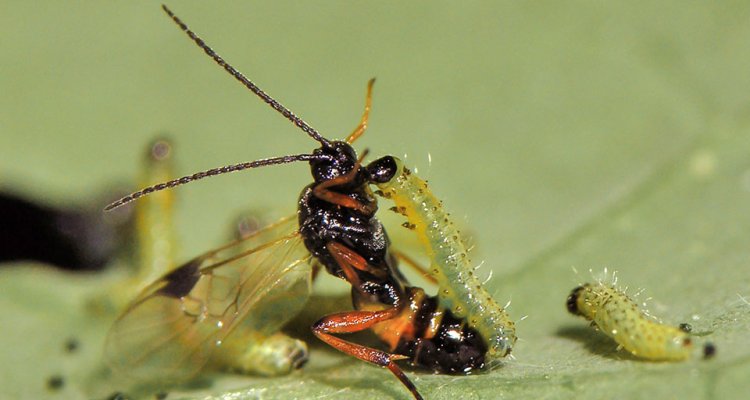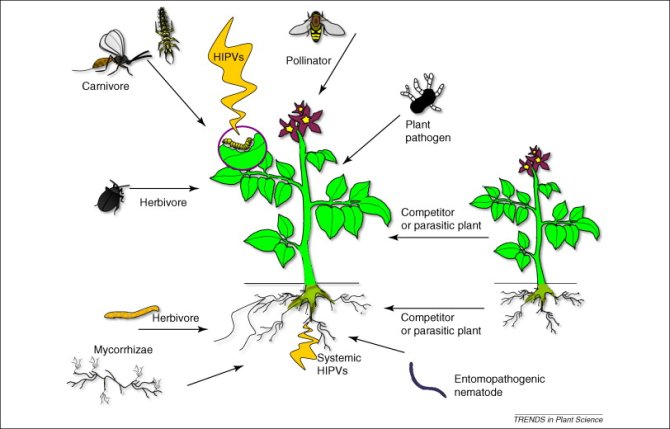
Marcel Dicke's research
Insects and mites are small organisms that are very well informed about their environment. They can use chemical cues such as volatiles or non-volatile cues to obtain information on the presence of e.g. their food, competitors, sexual partners, and enemies. Insects are members of complex communities consisting of e.g. plants, herbivorous, carnivorous arthropods and pollinators.
The ecology of body odour
Herbivorous and carnivorous arthropods use plant volatiles when foraging for food. In response to herbivory plants emit a chemical blend that may be quantitatively and qualitatively different from the blend emitted when intact (plant ‘cry for help’). This induced volatile blend alters the interactions of the plant with its environment. It has been well established that carnivores (predators and parasitoids) are attracted by the volatiles induced by their herbivorous victims. Apart from a benefit from attracting carnivores, the induced volatiles can have a serious cost because herbivores may be attracted. Yet, whether the attracted herbivores settle on the plant that emits the volatiles may depend on the presence of herbivore and/or carnivore cues that indicate that the plant is a competitor- and/or enemy-dense space. Thus, the benefit of emission of induced volatiles is likely to depend on environmental conditions. Whether plants can influence the emission of the induced volatiles, taking the prevalent environmental conditions into account, is an interesting question that needs to be addressed. The induced volatiles may also affect interactions of the emitting plant with its neighbours, e.g. through altered competitive ability or by the neighbour exploiting the emitted information. This is a topic that should receive more attention.We investigate the ecology of infochemicals through a multidisciplinary approach, from genes to the community.
Apart from research on infochemicals in plant-arthropod interactions, we have also started a study on the role of infochemicals in chicken-mite interactions and the potential for exploiting the infochemicals to control mites that attack chicken.
Our research focuses on:
- Chemical ecology of multitrophic interactions: what chemicals are induced in plants by herbivory, what is their effect on arthropod behaviour, and how do the cues affect interactions in the community?
- Plant-mediated interactions among microbes, herbivorous insects, carnivorous insects and pollinating insects.
- Molecular ecology of multitrophic interactions: what signal-transduction pathways are induced in plants by herbivory, what genes are induced, what transcriptome changes occur in response to attack by different types of organisms?
- Behavioural ecology of predator avoidance: how do predator cues affect prey behaviour?

Publications
-
Folivory Affects Composition of Nectar, Floral Odor and Modifies Pollinator Behavior
Journal of Chemical Ecology (2014), Volume: 40, Issue: 1 - ISSN 0098-0331 - p. 39-49. -
Response of the zoophytophagous predators Macrolophus pygmaeus and Nesidiocoris tenuis to volatiles of uninfested plants and to plants infested by prey or conspecifics
BioControl (2014), Volume: 59, Issue: 6 - ISSN 1386-6141 - p. 707-718. -
Body odors of parasitized caterpillars give away the presence of parasitoid larvae to their primary hyperparasitoid enemies
Journal of Chemical Ecology (2014), Volume: 40, Issue: 9 - ISSN 0098-0331 - p. 986-995. -
Effect of sequential induction by Mamestra brassicae L. and Tetranychus urticae Koch on Lima bean plant indirect defense
Journal of Chemical Ecology (2014), Volume: 40, Issue: 9 - ISSN 0098-0331 - p. 977-985. -
Rearing history affects behaviour and performance of two virulent Nasonovia ribisnigri populations on two lettuce cultivars
Entomologia Experimentalis et Applicata (2014), Volume: 151, Issue: 2 - ISSN 0013-8703 - p. 97-105. -
Plant interactions with multiple insect herbivores: from community to genes
Annual Review of Plant Biology (2014), Volume: 65 - ISSN 1543-5008 - p. 689-713. -
Plant volatiles and the environment
Plant, Cell & Environment (2014), Volume: 37, Issue: 8 - ISSN 0140-7791 - p. 1905-1908. -
Modulation of flavonoid metabolites in Arabidopsis thaliana through overexpression of the MYB75 transcription factor: role of kaempferol-3,7-dirhamnoside in resistance to the specialist insect herbivore Pieris brassicae
Journal of Experimental Botany (2014), Volume: 65, Issue: 8 - ISSN 0022-0957 - p. 2203-2217. -
Insect herbivore- associated organisms affect plant responses to herbivory
New Phytologist (2014), Volume: 204, Issue: 2 - ISSN 0028-646X - p. 315-321. -
Life-history analysis of Thaumastocoris peregrinus in a newly designed mass rearing strategy
Bulletin of Insectology (2014), Volume: 67, Issue: 2 - ISSN 1721-8861 - p. 199-205.